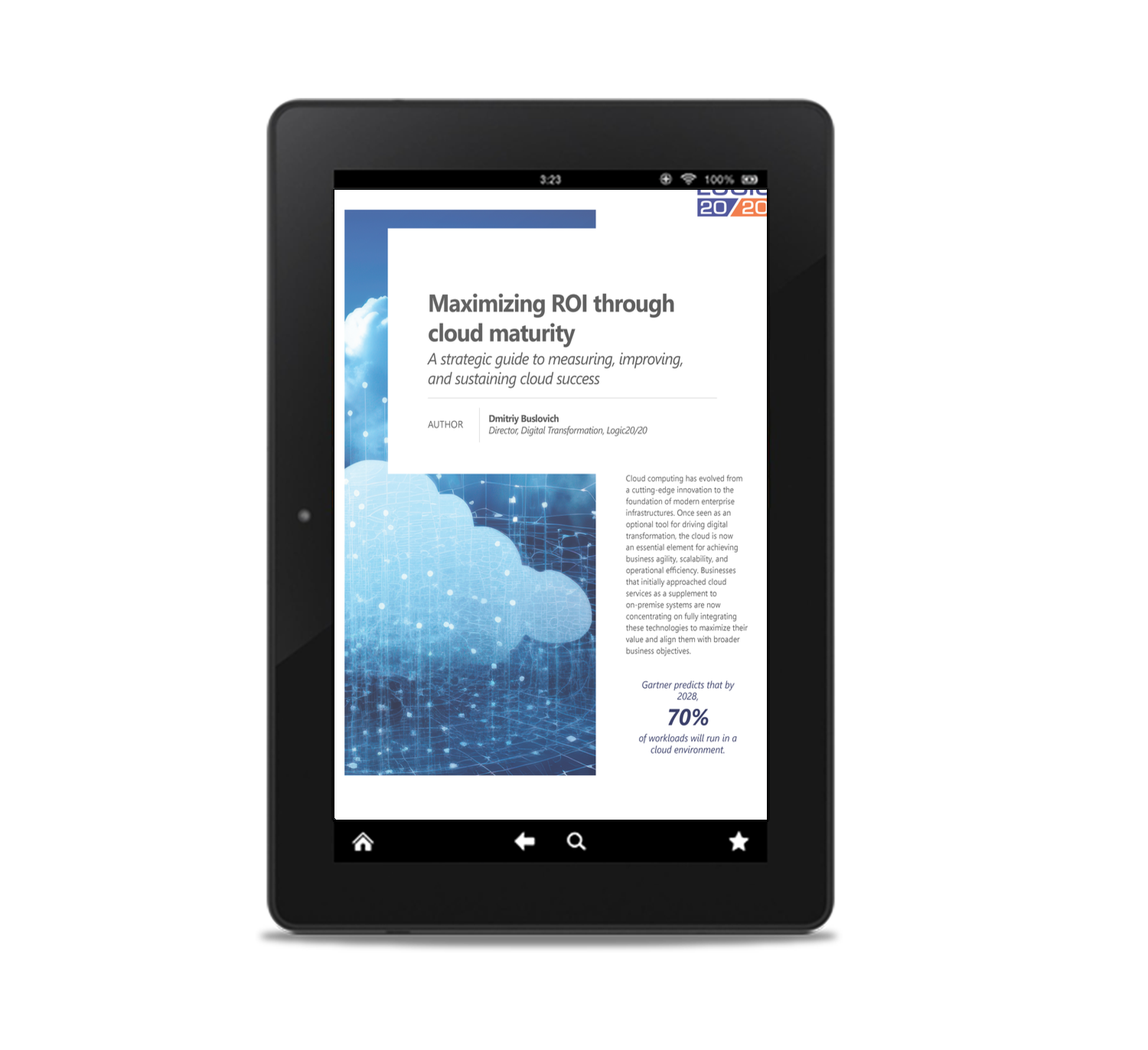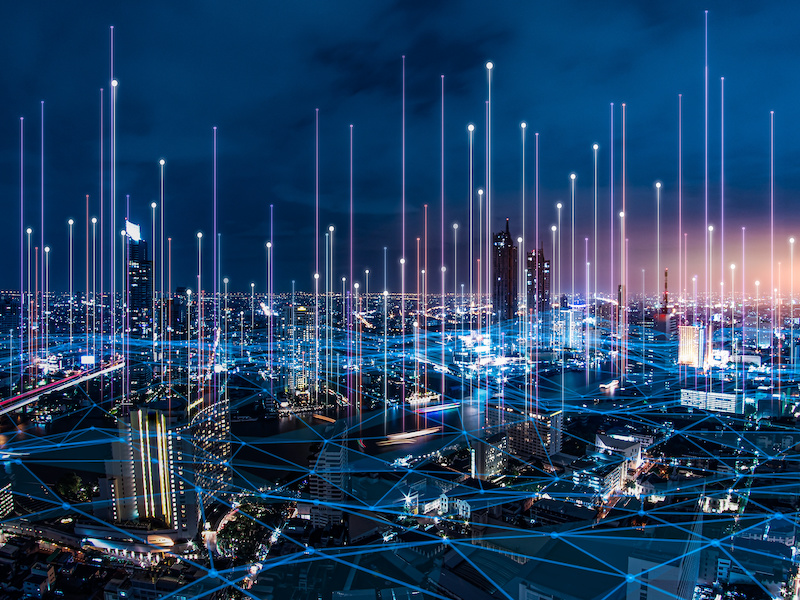5-minute read
Quick summary: As the grid of the future begins to take shape, we explore how cloud computing is accelerating the incorporation of renewable energy sources.
Driven by a perfect storm of economic, regulatory, and operational factors, growth in renewable energy resources is accelerating at a rapid pace. The shape of the grid is changing as monolithic, one-way transmission and delivery structures give way to intricate webs of suppliers and consumers connected by bidirectional pathways. Managing this evolving grid profile requires fresh approaches to technology, which in turn require innovative perspectives on IT architectures.
In this article, we’ll explore why cloud computing is essential in managing the renewable sources that are shaping the grid of the future.
Article continues below.

Download “Maximizing ROI through cloud maturity”
We will never sell your data. View our privacy policy here.
Powering big changes in the grid
In 2023, renewable sources generated 893.5 terawatt hours of power in the United States. Building the first 50 GW of U.S. solar capacity took 18 years—but doubling that to 100 GW took only four.
The drivers for current and future growth in utility-scale renewable energy sources and DERs are as powerful as they are diverse. These include the following:
Net-zero-emission goals
The U.S. government has set a national goal of 100 percent clean electricity by 2035, and 24 states plus the District of Columbia and Puerto Rico have set their own clean-energy goals for electricity, with target dates ranging from 2032 to 2050.
FERC Order No. 2222
Released in 2020, FERC Order No. 2222 requires grid operators to enable aggregators of distributed energy resources (DERs) to participate directly in regional wholesale electricity markets.
Increasing peak loads
Increases in electrification of buildings and penetration of EVs and heat pumps are escalating peak loads on the grid, requiring the incorporation of alternative sources to provide additional capacity.
Cost factors
In 2022, residential electricity prices increased by 10.7 percent, the highest year-over-year growth registered since the beginning of the century, and grew again by four percent in 2023. At the same time, the cost of rooftop photovoltaic (PV) panels has decreased by 64 percent since 2010, and consumers can reduce their net cost further by taking advantage of federal tax credits.
How cloud computing accelerates incorporation of renewable energy sources
Incorporating renewable energy sources into legacy grid operations requires alternative approaches to power supply forecasting and to the monitoring and control of grid assets.
Here are six ways cloud-based digital solutions are enabling utilities to meet the demands of the grid of the future while maintaining a reliable flow of electricity when and where it’s needed.
1. Connectivity with smart devices
While internet-of-things (IoT) devices are not new to the utilities industry, successfully integrating renewables will require increased use of smart devices and escalated capacities for monitoring and control.
Smart devices connected by the cloud enable a cost-efficient solution for monitoring and controlling renewable energy assets in near-real time. These devices include
- Sensors for collecting and transmitting data
- Actuators for converting energy into motion
- Communication devices to transmit data in both directions
For example, cloud-based IoT management systems allow utilities to control solar panels’ dual-axis trackers remotely to ensure maximum efficiency as sunlight patterns change throughout the day.
2. Private wireless networks
Private wireless networks, also known as private LTEs (PLTEs), are privately owned cellular networks designed and built solely for use by a specific organization. Only authorized users have access, and the organization determines where there will be coverage and how the network should perform.
These private networks offer the security, reliability, and low latency utilities need to support extensive networks of IoT devices related to renewable energy.
San Diego Gas & Electric (SDG&E), for example, deployed a private wireless network to support various use cases, including metering, fault detection and location, mission-critical push-to-talk (MCPTT), and supervisory control and data acquisition (SCADA). “We also see this system helping us more effectively serve the growing renewable power and energy storage systems connected to our grid,” said Omar Zevallos, SDG&E’s manager of network technologies, “as well as meeting growing demands for electric vehicle charging and other new loads.”
3. Edge computing
Edge computing enables data to be processed at or close to the location where the data originates. For utilities, these locations could include individual field assets such as wind turbines, smart meters, and DERs. Edge computing is ideally suited for applications requiring rapid decision-making and response, and the cloud enables rapid communication between edge devices and edge servers, allowing devices to be monitored and controlled in real or near-real time.
4. Supporting scalability and decentralization of energy resources
The cloud enables utilities to scale their data storage and compute power as needed to accommodate the demands of the evolving and increasingly decentralized grid. One key driver behind these changes is the rise of the “prosumer”—utility customers who produce their own energy (usually via renewable sources such as wind and solar) in addition to consuming electricity from the grid as needed. As the U.S. Office of Energy Efficiency and Renewable Energy asserted in a recent article, “Gone are the days when electricity consumption was a one-way street. Today’s electric grid is blurring the lines between power generation and consumption.”
Cloud computing enables utilities to better manage their prosumer relationships by (a) providing efficient storage for the massive amounts of data moving back and forth and (b) enabling near-real-time processing of data regarding the customer’s electricity production and consumption.
5. Artificial intellligence and machine learning
Artificial intelligence and machine learning help utilities better manage renewable energy sources in multiple use cases, including forecasting energy outputs, scheduling maintenance, and managing power flows. Many cloud providers offer AI and machine learning applications to their customers, enabling utilities to get these capabilities up and running more quickly than if they had to build them in-house.
The cloud also offers the high-performant processing needed to create real-time, AI-driven insights regarding production, consumption, and management of renewable energy.
6. Web3 capabilities
In peer-to-peer (P2P) trading of renewable energy, consumers and producers “meet” (virtually) to buy and sell electricity directly without the need for an intermediary. This model can improve management of decentralized resources by facilitating continuous balance of renewable energy supply and demand. Many cloud platforms provide secure Web3 applications, which function similar to blockchain platforms in supporting P2P trades.
Web3 also offers the benefit of transparency in critical areas such as carbon offsetting via the trading of carbon credits. By measuring and processing environmental data in real time, Web3 solutions such as distributed ledger technologies (DLTs) can help improve standardization and accountability, preventing deceitful practices such as “greenwashing.”
Finally, Web3 enables the creation of “smart contracts”—self-executing agreements between utility companies and customers that require no human intervention. For example, when electricity prices reach a certain threshold, a prearranged smart contract might automatically kick in to turn down or turn off certain high-usage appliances via an IoT controller.
Beyond renewables: how the cloud is shaping the smart grid of the future
The IEA defines a smart grid as “an electricity network that uses digital and other advanced technologies to monitor and manage the transport of electricity from all generation sources to meet the varying electricity demands of end users.” The agency further affirms that “investment in smart grids needs to more than double through to 2030 to get on track with the Net Zero Emissions by 2050 Scenario.”
The smart grid is a necessary precursor to a cleaner, greener energy future. And because utilities need real-time information to manage supply and demand for power from renewable sources, the cloud is a necessary precursor to the smart grid.
Besides enabling two-way flows of electricity and data between utilities and customers, the cloud supports progress towards the smart grid in multiple ways:
- Grid self-healing: Cloud computing enables utilities to leverage data for fault location and isolation, service restoration, and predictive maintenance based on sensor data.
- Smart metering: Utilities can leverage cloud resources to activate sensors, IoT architectures, and edge computing in delivering real-time insights on energy usage.
- Prosumer enablement: A cloud-driven smart grid enables consumers with renewable energy sources to act as producers, enabling the decentralization of energy generation.
- Electricity storage: With cloud computing, utilities can manage electricity storage assets in real time to balance fluctuations in energy supply and demand.
- Data security: By building cloud-based private wireless networks, utilities can leverage the benefits of cloud computing while avoiding many of the cybersecurity risks involved in using public networks.
Anticipating a cleaner, smarter grid—thanks to the cloud
As utilities progress towards a future where renewable energy is the primary source of electricity, a new way of thinking about and managing the flow of power—and the data surrounding it—is essential. By leveraging cloud computing and related technologies, electricity producers can accelerate towards their goals while embracing all the advantages that the smart grid of the future has to offer.

Powering a sustainable tomorrow
- Smart automation
- DERMS implementation
- Analytics & predictive insights
- Cloud optimization

Lionel Bodin is the Senior Director of Digital Transformation at Logic20/20. He manages highly complex, multi-faceted digital programs related to CRM systems, cloud and on-prem implementations, big data, and more.

